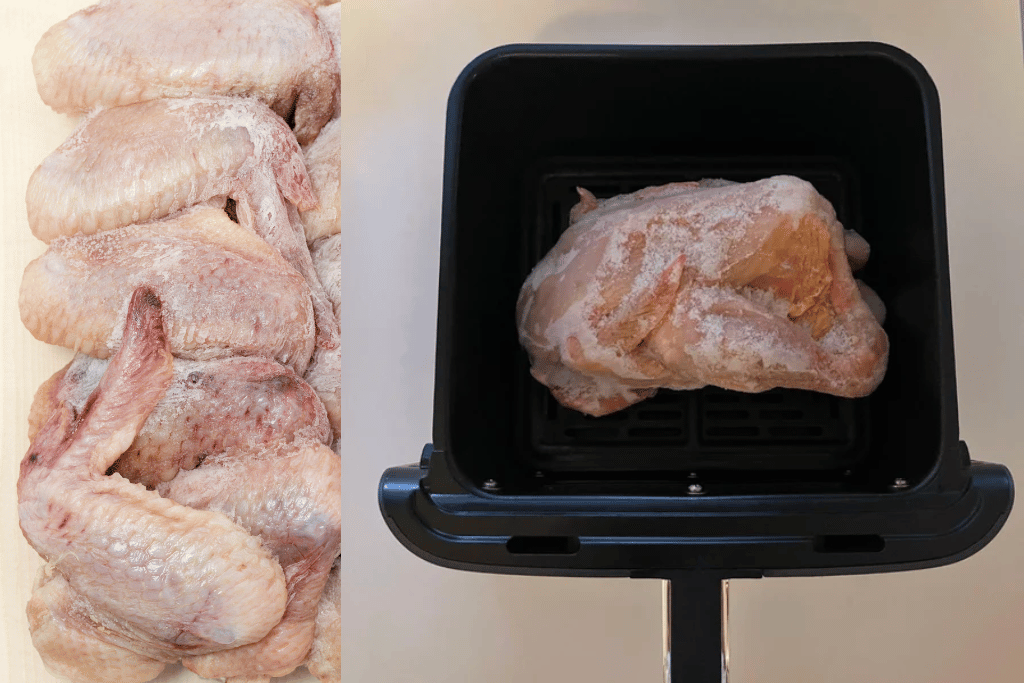
Image Source: bigairfryers.com
Can You Defrost In A Ninja Air Fryer? Is It Faster & Safer?
Yes, you can defrost in a Ninja air fryer. Many Ninja air fryer models have a specific “defrost” setting, making it a potentially faster option than traditional methods. However, whether it’s safer depends on how carefully you follow guidelines. Let’s explore this in detail.
Unveiling the Ninja Air Fryer’s Defrost Function
Ninja air fryers are known for their versatility, going beyond simple air frying. Many models include functions like roasting, baking, dehydrating, and, importantly, defrosting. This feature aims to gently bring frozen food to a safe temperature for cooking. If your Ninja air fryer has an air fryer defrost setting, you’re in luck, as it is specifically designed for this task.
How the Air Fryer Defrost Setting Works
The air fryer defrost setting works by circulating air at very low temperatures. This prevents the outside of the food from cooking while the inside remains frozen. Unlike microwaving, which can start cooking the edges, an air fryer aims for a more even thaw.
Ninja Foodi Defrost: A Special Case
The Ninja Foodi takes things a step further. As a multi-cooker, it combines the functions of a pressure cooker, air fryer, and more. The Ninja Foodi defrost function is generally very effective because it offers precise temperature control. This is crucial for safe thawing.
Benefits of Using an Air Fryer for Defrosting
Why consider using your air fryer to defrost? Here are some advantages:
- Speed: Often faster than thawing in the refrigerator or under cold water.
- Convenience: Set it and (mostly) forget it. You can do other things while your food defrosts.
- Reduced Risk of Bacterial Growth: When done correctly, it minimizes the time food spends in the “danger zone” (40°F – 140°F), where bacteria thrive.
- Even Thawing: Aims for a more consistent thaw compared to other methods.
The Risks of Thawing Meat in Air Fryer
While convenient, defrosting in an air fryer isn’t without potential risks. Here’s what you need to be aware of:
- Partial Cooking: If the temperature is too high or the defrost time is too long, the outside of the food can start to cook.
- Uneven Thawing: Some parts of the food may thaw faster than others, leading to potential bacterial growth in the warmer areas.
- Overheating: Leaving food in the air fryer for too long can raise its temperature into the danger zone, increasing the risk of foodborne illness.
A Step-by-Step Air Fryer Defrost Guide
To ensure safe and effective defrosting, follow these steps:
- Check Your Air Fryer Manual: This is the most important step. Your manual will provide specific instructions and recommended times for your model.
- Prepare the Food: Remove the food from its packaging. If there are multiple pieces, separate them to ensure even thawing.
- Use the Defrost Setting: If your air fryer has a defrost setting, use it. If not, set the temperature as low as possible (usually around 80°F-100°F).
- Monitor the Food: Check the food frequently, especially during the last half of the defrosting time. Use a food thermometer to ensure the internal temperature stays below 40°F.
- Flip the Food: Turn the food over halfway through the defrosting time for even thawing.
- Cook Immediately: Once defrosted, cook the food immediately. Do not refreeze.
Defrost Chicken Air Fryer: Special Considerations
Defrost chicken air fryer requires extra caution due to the high risk of salmonella. Here’s a specific guide:
- Follow Air Fryer Manual: Prioritize the manual’s instructions for poultry.
- Temperature: Use the lowest possible temperature on the defrost setting.
- Time: Start with a short time, like 5-10 minutes, and check frequently.
- Internal Temperature: Use a food thermometer to ensure the internal temperature stays below 40°F.
- Immediate Cooking: Cook the chicken immediately after defrosting to a safe internal temperature (165°F).
Defrosting Different Types of Food in the Air Fryer
The time and temperature required for defrosting vary depending on the type of food. Here’s a general guide:
Table: Defrosting Guidelines for Different Foods in an Air Fryer
| Food Type | Temperature | Time | Important Notes |
|---|---|---|---|
| Chicken Breast | 80°F – 100°F | 5-15 minutes | Check frequently. Ensure it stays below 40°F. Cook immediately after thawing. |
| Ground Beef | 80°F – 100°F | 5-10 minutes | Break it up into smaller pieces for even thawing. |
| Fish Fillets | 80°F – 100°F | 3-7 minutes | Delicate, so check very frequently. |
| Shrimp | 80°F – 100°F | 2-5 minutes | Very quick thawing. Watch carefully to prevent cooking. |
| Steak | 80°F – 100°F | 5-12 minutes | Thicker steaks may need slightly longer. Ensure even thawing by flipping. |
| Pork Chops | 80°F – 100°F | 5-12 minutes | Ensure no pink remains after cooking. |
Note: These are estimates. Always refer to your air fryer manual and use a food thermometer.
Is Using an Air Fryer for Frozen Food A Good Idea?
The use of an air fryer for frozen food in general is quite popular due to the crispy texture it achieves without excessive oil. But using it for defrosting needs a different approach. Whether using an air fryer to defrost is a good idea depends on your situation. If you need something thawed quickly and can monitor it closely, it can be a convenient option. However, if you are unsure or don’t have the time to keep a close watch, other methods may be safer.
Comparing Air Fryer Defrosting to Other Methods
Let’s compare air fryer defrosting to other common methods:
Table: Comparison of Defrosting Methods
| Method | Speed | Safety | Convenience | Considerations |
|---|---|---|---|---|
| Air Fryer | Medium | Can be safe if monitored closely, but risk of partial cooking. | Medium | Requires active monitoring. Check manual for specific instructions. |
| Refrigerator | Slow | Safest method, but takes the longest. | Low | Requires planning ahead. |
| Cold Water | Medium | Relatively safe if water is changed every 30 minutes. | Medium | Requires attention to ensure water stays cold. Food must be in a leak-proof bag. |
| Microwave | Fast | Higher risk of partial cooking. Can make food rubbery. | High | Requires immediate cooking after thawing. Can create hot spots. |
Tips for How to Defrost Quickly Air Fryer Style:
- Smaller Pieces: Cut food into smaller pieces before freezing (if possible) to speed up the thawing process.
- Lower Temperature: Use the lowest possible temperature setting.
- Frequent Checks: Check the food every few minutes.
- Food Thermometer: Use a food thermometer to monitor the internal temperature.
- Immediate Cooking: Cook immediately after thawing.
How Safe is the Ninja Air Fryer Defrost Frozen Function?
The Ninja air fryer defrost frozen function, like any defrosting method, has safety considerations. The main risk is allowing the food to enter the “danger zone” (40°F – 140°F) for too long, which can promote bacterial growth. To mitigate this risk:
- Monitor Closely: Don’t leave the air fryer unattended while defrosting.
- Use a Thermometer: Ensure the food stays below 40°F.
- Cook Immediately: Cook the food immediately after defrosting to a safe internal temperature.
What is the Best Way to Defrost in Air Fryer?
The best way to defrost in air fryer involves a combination of using the appropriate settings, monitoring the food closely, and following safety guidelines. Here’s a recap:
- Consult Your Manual: Every air fryer is different, so start here.
- Use the Defrost Setting (If Available): This is the most controlled option.
- Low Temperature: If no defrost setting, use the lowest temperature possible (80°F – 100°F).
- Frequent Checks: Check the food frequently.
- Food Thermometer: Monitor the internal temperature (below 40°F).
- Cook Immediately: Cook the food immediately after defrosting.
Considerations for Ninja Air Fryer Frozen Meat
When dealing with ninja air fryer frozen meat, particularly larger cuts, consider these factors:
- Size Matters: Larger cuts take longer to defrost and are more prone to uneven thawing. Consider cutting them into smaller portions before freezing.
- Rotation: Rotate the meat frequently to ensure even thawing.
- Thermometer is Key: The food thermometer is your best friend in ensuring safe defrosting.
Troubleshooting Common Issues
- Food is Cooking on the Outside: Reduce the temperature or defrost time.
- Food is Still Frozen in the Middle: Increase the defrost time slightly and ensure even air circulation.
- Uneven Thawing: Rotate the food more frequently.
Conclusion
Using a Ninja air fryer to defrost food can be a convenient and relatively fast method. However, it requires careful attention to detail and adherence to safety guidelines. Always prioritize food safety by monitoring the temperature and cooking the food immediately after thawing. By following these guidelines, you can safely and effectively defrost food in your Ninja air fryer.
Frequently Asked Questions (FAQ)
Q: Can I defrost ground beef in my Ninja air fryer?
A: Yes, you can. Break it up into smaller pieces before defrosting for more even thawing.
Q: Is it safe to defrost fish in an air fryer?
A: Yes, but fish is delicate and thaws quickly. Watch it very closely to prevent cooking.
Q: How long does it take to defrost chicken breast in an air fryer?
A: It usually takes 5-15 minutes at a low temperature (80°F – 100°F). Check frequently and use a food thermometer.
Q: Can I refreeze food after defrosting it in the air fryer?
A: No, it is not safe to refreeze food after it has been defrosted. Cook it immediately.
Q: My air fryer doesn’t have a defrost setting. Can I still use it to defrost?
A: Yes, set the temperature to the lowest possible setting (usually around 80°F – 100°F) and monitor the food closely.
Q: How do I know when the food is fully defrosted?
A: The food should be pliable but still very cold to the touch. Use a food thermometer to ensure the internal temperature is below 40°F.
Q: What if the outside of the food starts to cook during defrosting?
A: Reduce the temperature or defrost time. If necessary, transfer the food to the refrigerator to finish thawing.

I’m the recipe developer and food photographer behind Air Fryer at Tiffany’s. I’m also a wife, mom to two adventurous little boys, registered nurse, and live in the great Midwest. Join me as I show you new ways to use your air fryer that you never knew possible.